Succinic acid (B) can be prepared by both nitrile and carbonation method as shown.

Both paths give good yields of (B).
(A) with Mg would lead to the loss of vicinal Br atoms to give alkene and MgBr2.
If both (A) are (R) are true and (R) is the correct explanation of (A).
If both (A) and (R) are true but (R) is not the correct explanation of (A).
If (A) is true but (R) is false.
If (A) is false but (R) is true.
The correct Answer is:D
Step by step video & image solution for Succinic acid (B) can be prepared by both nitrile and carbonation method as shown. Both paths give good yields of (B). (A) with Mg would lead to the loss of vicinal Br atoms to give alkene and MgBr_2. by Chemistry experts to help you in doubts & scoring excellent marks in Class 12 exams.
Updated on:21/07/2023Topper's Solved these Questions
- CARBOXYLIC ACIDS AND THEIR DERIVATIVESBOOK - CENGAGE CHEMISTRY ENGLISHCHAPTER - CARBOXYLIC ACIDS AND THEIR DERIVATIVESEXERCISE - Exercises Archives (Single Correct)
10 Videos
- CARBOXYLIC ACIDS AND THEIR DERIVATIVESBOOK - CENGAGE CHEMISTRY ENGLISHCHAPTER - CARBOXYLIC ACIDS AND THEIR DERIVATIVESEXERCISE - Exercises Archives (Assertion-Reasoning)
2 Videos
- CARBOXYLIC ACIDS AND THEIR DERIVATIVESBOOK - CENGAGE CHEMISTRY ENGLISHCHAPTER - CARBOXYLIC ACIDS AND THEIR DERIVATIVESEXERCISE - Exercises (Singlecorrect)
64 Videos
- BIOMOLECULESBOOK - CENGAGE CHEMISTRY ENGLISHCHAPTER - BIOMOLECULESEXERCISE - Exercises Archives (Analytical And Descriptive)
8 Videos
- CHEMICAL KINETICSBOOK - CENGAGE CHEMISTRY ENGLISHCHAPTER - CHEMICAL KINETICSEXERCISE - Archives Subjective
23 Videos
Similar Questions
3−Phenol propanic acid (B) can be prepared by both nitrile and carbonation method as shown.

Path I gives a good yield of (B).
ӨCN initiates elimination reaction.
View Solution(i) A powdered substance (A) on treatment with fusion mixture gives a green coloured compound (B). (ii) The solution of (B) in boiling water on acidification with dilute H2SO4 gives a pink coloured compound (C).
(iii) The aqueous solution of (A) on treatment with NaOH and Br2− water gives a compound (D).
(iv) A solution of (D) in conc. HNO3 on treatment with lead peroxide at boiling temperature produced a compound (E) which was of the same color at that of (C).
(v) A solution of (A) on treatment with a solution of barium chloride gave a white precipitate of compound (F) Which was insoluble in conc. HNO3 and conc. HCl.
Consider the following statement :
(I) Anions of both (B) and (C ) are diamagnetic and have tetradhedral geometray.
(II) Anions of both (B) and ( C) are paramagnetic and have tetrahedral geometry.
(III) Anions of (B) is paramagnetic and that of (C ) is diamagnetic but both have same tetrahedral geometry.
(IV) Green coloured compound (B) in a neutral of acidic medium disproportionates to give (C ) and (D).
Of these select the correct one from the code given :
View Solution
Knowledge Check
Every day, millions of shoppers hit the stores in
full force—both online and on foot—searching
frantically for the perfect gift. Last year, Americans
spent over $30 billion at retail stores in the month of
5 December alone. Aside from purchasing holiday
gifts, most people regularly buy presents for other
occasions throughout the year, including weddings,
birthdays, anniversaries, graduations, and baby
showers. This frequent experience of gift-giving can
10 engender ambivalent feelings in gift-givers. Many
relish the opportunity to buy presents because
gift-giving offers a powerful means to build stronger
bonds with one’s closest peers. At the same time,
many dread the thought of buying gifts, they worry
15 that their purchases will disappoint rather than
delight the intended recipients.
Anthropologists describe gift-giving as a positive
social process, serving various political, religious, and
psychological functions. Economists, however, offer
20 a less favorable view. According to Waldfogel (1993),
gift-giving represents an objective waste of resources.
People buy gifts that recipients would not choose to
buy on their own, or at least not spend as much
money to purchase (a phenomenon referred to as
25 ‘‘the deadweight loss of Christmas”). To wit, givers
are likely to spend $100 to purchase a gift that
receivers would spend only $80 to buy themselves.
This ‘‘deadweight loss” suggests that gift-givers are
not very good at predicting what gifts others will
30 appreciate. That in itself is not surprising to social
psychologists. Research has found that people often
struggle to take account of others’ perspectives—
their insights are subject to egocentrism, social
projection, and multiple attribution errors.
35 What is surprising is that gift-givers have
considerable experience acting as both gift-givers and
gift-recipients, but nevertheless tend to overspend
each time they set out to purchase a meaningful gift.
In the present research, we propose a unique
40 psychological explanation for this overspending
problem—i.e., that gift-givers equate how much they
spend with how much recipients will appreciate the
gift (the more expensive the gift, the stronger a
gift-recipient’s feelings of appreciation). Although a
45 link between gift price and feelings of appreciation
might seem intuitive to gift-givers, such an
assumption may be unfounded. Indeed, we propose
that gift-recipients will be less inclined to base their
feelings of appreciation on the magnitude of a gift
50 than givers assume.
Why do gift-givers assume that gift price is closely
linked to gift-recipients’ feelings of appreciation?
Perhaps givers believe that bigger (i.e., more
expensive) gifts convey stronger signals of
55 thoughtfulness and consideration. According to
Camerer (1988) and others, gift-giving represents a
symbolic ritual, whereby gift-givers attempt to signal
their positive attitudes toward the intended recipient
and their willingness to invest resources in a future
60 relationship. In this sense, gift-givers may be
motivated to spend more money on a gift in order to
send a “stronger signal” to their intended recipient.
As for gift-recipients, they may not construe smaller
and larger gifts as representing smaller and larger
65 signals of thoughtfulness and consideration.
The notion of gift-givers and gift-recipients being
unable to account for the other party’s perspective
seems puzzling because people slip in and out of
these roles every day, and, in some cases, multiple
70 times in the course of the same day. Yet, despite the
extensive experience that people have as both givers
and receivers, they often struggle to transferinformation gained from one role (e.g., as a giver)
and apply it in another, complementary role (e.g., as
75 a receiver). In theoretical terms, people fail to utilize
information about their own preferences and
experiences in order to produce more efficient
outcomes in their exchange relations. In practical
terms, people spend hundreds of dollars each year on
gifts, but somehow never learn to calibrate their gift
expenditures according to personal insight.
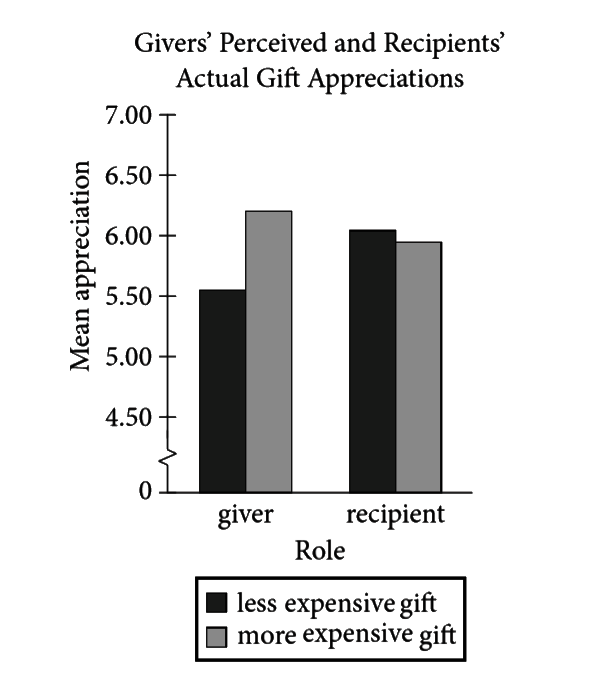
17. Which choice provides the best evidence for the answer to the previous question?ALines 53-55 (“Perhaps . . . consideration”)BLines 55-60 (“According . . . relationship”CLines 63-65 (“As . . . consideration”)DLines 75-78 (“In . . . relations”) 18Every day, millions of shoppers hit the stores in
full force—both online and on foot—searching
frantically for the perfect gift. Last year, Americans
spent over $30 billion at retail stores in the month of
5 December alone. Aside from purchasing holiday
gifts, most people regularly buy presents for other
occasions throughout the year, including weddings,
birthdays, anniversaries, graduations, and baby
showers. This frequent experience of gift-giving can
10 engender ambivalent feelings in gift-givers. Many
relish the opportunity to buy presents because
gift-giving offers a powerful means to build stronger
bonds with one’s closest peers. At the same time,
many dread the thought of buying gifts, they worry
15 that their purchases will disappoint rather than
delight the intended recipients.
Anthropologists describe gift-giving as a positive
social process, serving various political, religious, and
psychological functions. Economists, however, offer
20 a less favorable view. According to Waldfogel (1993),
gift-giving represents an objective waste of resources.
People buy gifts that recipients would not choose to
buy on their own, or at least not spend as much
money to purchase (a phenomenon referred to as
25 ‘‘the deadweight loss of Christmas”). To wit, givers
are likely to spend $100 to purchase a gift that
receivers would spend only $80 to buy themselves.
This ‘‘deadweight loss” suggests that gift-givers are
not very good at predicting what gifts others will
30 appreciate. That in itself is not surprising to social
psychologists. Research has found that people often
struggle to take account of others’ perspectives—
their insights are subject to egocentrism, social
projection, and multiple attribution errors.
35 What is surprising is that gift-givers have
considerable experience acting as both gift-givers and
gift-recipients, but nevertheless tend to overspend
each time they set out to purchase a meaningful gift.
In the present research, we propose a unique
40 psychological explanation for this overspending
problem—i.e., that gift-givers equate how much they
spend with how much recipients will appreciate the
gift (the more expensive the gift, the stronger a
gift-recipient’s feelings of appreciation). Although a
45 link between gift price and feelings of appreciation
might seem intuitive to gift-givers, such an
assumption may be unfounded. Indeed, we propose
that gift-recipients will be less inclined to base their
feelings of appreciation on the magnitude of a gift
50 than givers assume.
Why do gift-givers assume that gift price is closely
linked to gift-recipients’ feelings of appreciation?
Perhaps givers believe that bigger (i.e., more
expensive) gifts convey stronger signals of
55 thoughtfulness and consideration. According to
Camerer (1988) and others, gift-giving represents a
symbolic ritual, whereby gift-givers attempt to signal
their positive attitudes toward the intended recipient
and their willingness to invest resources in a future
60 relationship. In this sense, gift-givers may be
motivated to spend more money on a gift in order to
send a “stronger signal” to their intended recipient.
As for gift-recipients, they may not construe smaller
and larger gifts as representing smaller and larger
65 signals of thoughtfulness and consideration.
The notion of gift-givers and gift-recipients being
unable to account for the other party’s perspective
seems puzzling because people slip in and out of
these roles every day, and, in some cases, multiple
70 times in the course of the same day. Yet, despite the
extensive experience that people have as both givers
and receivers, they often struggle to transferinformation gained from one role (e.g., as a giver)
and apply it in another, complementary role (e.g., as
75 a receiver). In theoretical terms, people fail to utilize
information about their own preferences and
experiences in order to produce more efficient
outcomes in their exchange relations. In practical
terms, people spend hundreds of dollars each year on
gifts, but somehow never learn to calibrate their gift
expenditures according to personal insight.
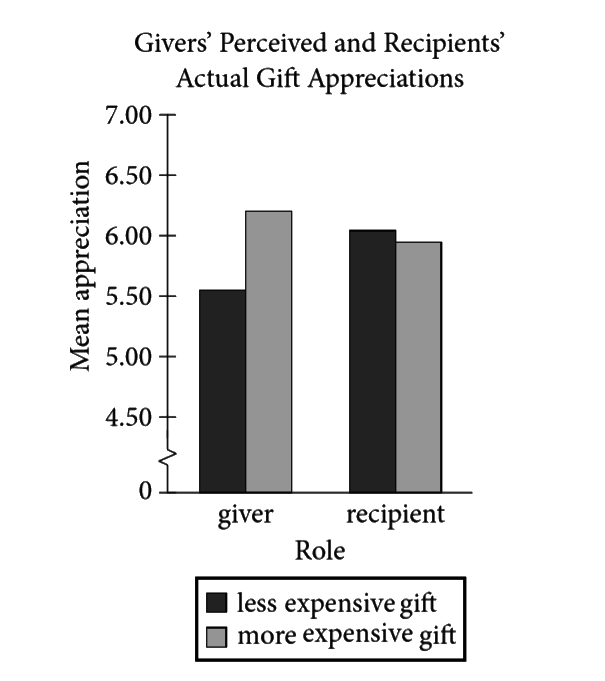
19. The authors refer to work by Camerer and others (line 56) in order toAoffer an explanation.Bintroduce an argumentCquestion a motive.Dsupport a conclusion.Every day, millions of shoppers hit the stores in
full force—both online and on foot—searching
frantically for the perfect gift. Last year, Americans
spent over $30 billion at retail stores in the month of
5 December alone. Aside from purchasing holiday
gifts, most people regularly buy presents for other
occasions throughout the year, including weddings,
birthdays, anniversaries, graduations, and baby
showers. This frequent experience of gift-giving can
10 engender ambivalent feelings in gift-givers. Many
relish the opportunity to buy presents because
gift-giving offers a powerful means to build stronger
bonds with one’s closest peers. At the same time,
many dread the thought of buying gifts, they worry
15 that their purchases will disappoint rather than
delight the intended recipients.
Anthropologists describe gift-giving as a positive
social process, serving various political, religious, and
psychological functions. Economists, however, offer
20 a less favorable view. According to Waldfogel (1993),
gift-giving represents an objective waste of resources.
People buy gifts that recipients would not choose to
buy on their own, or at least not spend as much
money to purchase (a phenomenon referred to as
25 ‘‘the deadweight loss of Christmas”). To wit, givers
are likely to spend $100 to purchase a gift that
receivers would spend only $80 to buy themselves.
This ‘‘deadweight loss” suggests that gift-givers are
not very good at predicting what gifts others will
30 appreciate. That in itself is not surprising to social
psychologists. Research has found that people often
struggle to take account of others’ perspectives—
their insights are subject to egocentrism, social
projection, and multiple attribution errors.
35 What is surprising is that gift-givers have
considerable experience acting as both gift-givers and
gift-recipients, but nevertheless tend to overspend
each time they set out to purchase a meaningful gift.
In the present research, we propose a unique
40 psychological explanation for this overspending
problem—i.e., that gift-givers equate how much they
spend with how much recipients will appreciate the
gift (the more expensive the gift, the stronger a
gift-recipient’s feelings of appreciation). Although a
45 link between gift price and feelings of appreciation
might seem intuitive to gift-givers, such an
assumption may be unfounded. Indeed, we propose
that gift-recipients will be less inclined to base their
feelings of appreciation on the magnitude of a gift
50 than givers assume.
Why do gift-givers assume that gift price is closely
linked to gift-recipients’ feelings of appreciation?
Perhaps givers believe that bigger (i.e., more
expensive) gifts convey stronger signals of
55 thoughtfulness and consideration. According to
Camerer (1988) and others, gift-giving represents a
symbolic ritual, whereby gift-givers attempt to signal
their positive attitudes toward the intended recipient
and their willingness to invest resources in a future
60 relationship. In this sense, gift-givers may be
motivated to spend more money on a gift in order to
send a “stronger signal” to their intended recipient.
As for gift-recipients, they may not construe smaller
and larger gifts as representing smaller and larger
65 signals of thoughtfulness and consideration.
The notion of gift-givers and gift-recipients being
unable to account for the other party’s perspective
seems puzzling because people slip in and out of
these roles every day, and, in some cases, multiple
70 times in the course of the same day. Yet, despite the
extensive experience that people have as both givers
and receivers, they often struggle to transferinformation gained from one role (e.g., as a giver)
and apply it in another, complementary role (e.g., as
75 a receiver). In theoretical terms, people fail to utilize
information about their own preferences and
experiences in order to produce more efficient
outcomes in their exchange relations. In practical
terms, people spend hundreds of dollars each year on
gifts, but somehow never learn to calibrate their gift
expenditures according to personal insight.
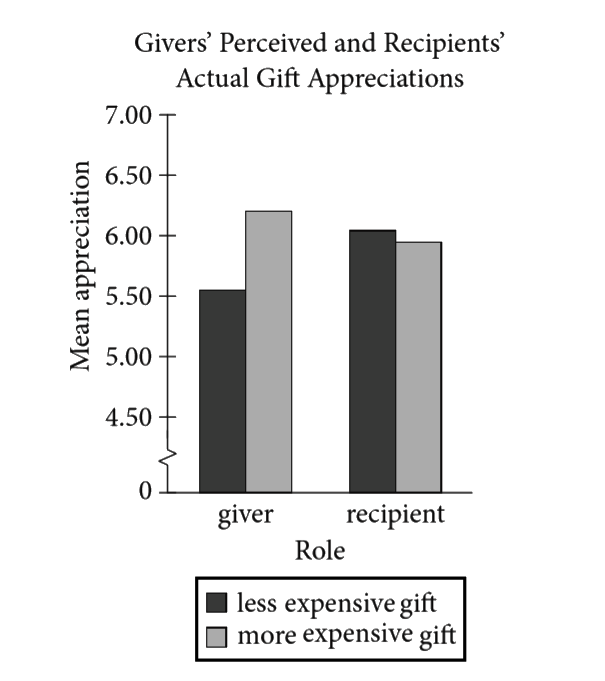
12. In line 10, the word “ambivalent” most nearly meansAunrealistic.Bconflicted.CapprehensiveDsupportive.
Three compounds A,B and C all have molecular formula C5H8 All the compound rapidly decolourise Br2 in CCl4. All three give a position test with Baeyer's reagent. And all the three are soluble in cold conc. H2SO4. Compound A gives a precipitate when treated with ammonical AgNO3 solution. but compounds B and C do not compounds A and B both yield pentane (C5H12) when they are treated with excess H2 in the presence of Pt catalyst. Under these conditions, compound C absorbs only one mole of H2 and gives a product with the formula C5H10 On oxidation with hot acidified KMnO_4, B gave acetic acid and CH_3CH_2COOH. Identify compounds A, B, and C.
View SolutionWe know that balancing of a chemical equation is entirely based on law of conservation of mass. However the concept of Principle of Atom Conservation (POAC) can also be related to law of conservation of mass in a chemical reaction.So, POAC can also act as a technique for balancing a chemical equation.For example, for a reaction :
ABC3→AB+C2
On applying POAC for A,B&C and relating the 3 equation, we get :.nABC32=.nAB2=.n_(c2)3 (nx : number of moles of x)
Thus, the coefficients of ABC3,AB & C2 in the balanced equation with be 2,2 & 3 respectively and the balanced chemical equation can be represented as :
2ABC3→2AB+3C2
Now answer the following questions :
If the weight ratio C and O2 presents 1:2 and both of reactants completely consume and form CO and CO2 and we will obtain a gasous mixture of CO and CO2.What would be the weight ratio of CO and CO2 in mixture.
View SolutionEvery day, millions of shoppers hit the stores in
full force—both online and on foot—searching
frantically for the perfect gift. Last year, Americans
spent over $30 billion at retail stores in the month of
5 December alone. Aside from purchasing holiday
gifts, most people regularly buy presents for other
occasions throughout the year, including weddings,
birthdays, anniversaries, graduations, and baby
showers. This frequent experience of gift-giving can
10 engender ambivalent feelings in gift-givers. Many
relish the opportunity to buy presents because
gift-giving offers a powerful means to build stronger
bonds with one’s closest peers. At the same time,
many dread the thought of buying gifts, they worry
15 that their purchases will disappoint rather than
delight the intended recipients.
Anthropologists describe gift-giving as a positive
social process, serving various political, religious, and
psychological functions. Economists, however, offer
20 a less favorable view. According to Waldfogel (1993),
gift-giving represents an objective waste of resources.
People buy gifts that recipients would not choose to
buy on their own, or at least not spend as much
money to purchase (a phenomenon referred to as
25 ‘‘the deadweight loss of Christmas”). To wit, givers
are likely to spend $100 to purchase a gift that
receivers would spend only $80 to buy themselves.
This ‘‘deadweight loss” suggests that gift-givers are
not very good at predicting what gifts others will
30 appreciate. That in itself is not surprising to social
psychologists. Research has found that people often
struggle to take account of others’ perspectives—
their insights are subject to egocentrism, social
projection, and multiple attribution errors.
35 What is surprising is that gift-givers have
considerable experience acting as both gift-givers and
gift-recipients, but nevertheless tend to overspend
each time they set out to purchase a meaningful gift.
In the present research, we propose a unique
40 psychological explanation for this overspending
problem—i.e., that gift-givers equate how much they
spend with how much recipients will appreciate the
gift (the more expensive the gift, the stronger a
gift-recipient’s feelings of appreciation). Although a
45 link between gift price and feelings of appreciation
might seem intuitive to gift-givers, such an
assumption may be unfounded. Indeed, we propose
that gift-recipients will be less inclined to base their
feelings of appreciation on the magnitude of a gift
50 than givers assume.
Why do gift-givers assume that gift price is closely
linked to gift-recipients’ feelings of appreciation?
Perhaps givers believe that bigger (i.e., more
expensive) gifts convey stronger signals of
55 thoughtfulness and consideration. According to
Camerer (1988) and others, gift-giving represents a
symbolic ritual, whereby gift-givers attempt to signal
their positive attitudes toward the intended recipient
and their willingness to invest resources in a future
60 relationship. In this sense, gift-givers may be
motivated to spend more money on a gift in order to
send a “stronger signal” to their intended recipient.
As for gift-recipients, they may not construe smaller
and larger gifts as representing smaller and larger
65 signals of thoughtfulness and consideration.
The notion of gift-givers and gift-recipients being
unable to account for the other party’s perspective
seems puzzling because people slip in and out of
these roles every day, and, in some cases, multiple
70 times in the course of the same day. Yet, despite the
extensive experience that people have as both givers
and receivers, they often struggle to transferinformation gained from one role (e.g., as a giver)
and apply it in another, complementary role (e.g., as
75 a receiver). In theoretical terms, people fail to utilize
information about their own preferences and
experiences in order to produce more efficient
outcomes in their exchange relations. In practical
terms, people spend hundreds of dollars each year on
gifts, but somehow never learn to calibrate their gift
expenditures according to personal insight.
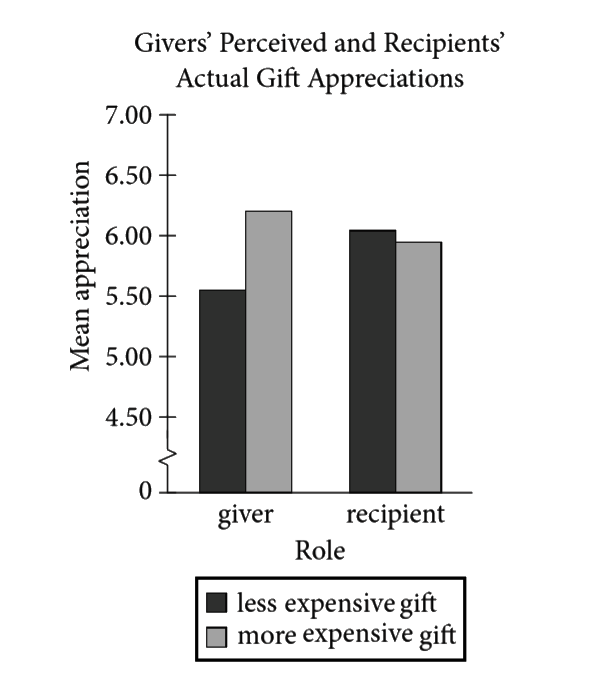
11. The authors most likely use the examples in lines 1-9of the passage (“Every . . .showers”) to highlight the
View SolutionEvery day, millions of shoppers hit the stores in
full force—both online and on foot—searching
frantically for the perfect gift. Last year, Americans
spent over $30 billion at retail stores in the month of
5 December alone. Aside from purchasing holiday
gifts, most people regularly buy presents for other
occasions throughout the year, including weddings,
birthdays, anniversaries, graduations, and baby
showers. This frequent experience of gift-giving can
10 engender ambivalent feelings in gift-givers. Many
relish the opportunity to buy presents because
gift-giving offers a powerful means to build stronger
bonds with one’s closest peers. At the same time,
many dread the thought of buying gifts, they worry
15 that their purchases will disappoint rather than
delight the intended recipients.
Anthropologists describe gift-giving as a positive
social process, serving various political, religious, and
psychological functions. Economists, however, offer
20 a less favorable view. According to Waldfogel (1993),
gift-giving represents an objective waste of resources.
People buy gifts that recipients would not choose to
buy on their own, or at least not spend as much
money to purchase (a phenomenon referred to as
25 ‘‘the deadweight loss of Christmas”). To wit, givers
are likely to spend $100 to purchase a gift that
receivers would spend only $80 to buy themselves.
This ‘‘deadweight loss” suggests that gift-givers are
not very good at predicting what gifts others will
30 appreciate. That in itself is not surprising to social
psychologists. Research has found that people often
struggle to take account of others’ perspectives—
their insights are subject to egocentrism, social
projection, and multiple attribution errors.
35 What is surprising is that gift-givers have
considerable experience acting as both gift-givers and
gift-recipients, but nevertheless tend to overspend
each time they set out to purchase a meaningful gift.
In the present research, we propose a unique
40 psychological explanation for this overspending
problem—i.e., that gift-givers equate how much they
spend with how much recipients will appreciate the
gift (the more expensive the gift, the stronger a
gift-recipient’s feelings of appreciation). Although a
45 link between gift price and feelings of appreciation
might seem intuitive to gift-givers, such an
assumption may be unfounded. Indeed, we propose
that gift-recipients will be less inclined to base their
feelings of appreciation on the magnitude of a gift
50 than givers assume.
Why do gift-givers assume that gift price is closely
linked to gift-recipients’ feelings of appreciation?
Perhaps givers believe that bigger (i.e., more
expensive) gifts convey stronger signals of
55 thoughtfulness and consideration. According to
Camerer (1988) and others, gift-giving represents a
symbolic ritual, whereby gift-givers attempt to signal
their positive attitudes toward the intended recipient
and their willingness to invest resources in a future
60 relationship. In this sense, gift-givers may be
motivated to spend more money on a gift in order to
send a “stronger signal” to their intended recipient.
As for gift-recipients, they may not construe smaller
and larger gifts as representing smaller and larger
65 signals of thoughtfulness and consideration.
The notion of gift-givers and gift-recipients being
unable to account for the other party’s perspective
seems puzzling because people slip in and out of
these roles every day, and, in some cases, multiple
70 times in the course of the same day. Yet, despite the
extensive experience that people have as both givers
and receivers, they often struggle to transferinformation gained from one role (e.g., as a giver)
and apply it in another, complementary role (e.g., as
75 a receiver). In theoretical terms, people fail to utilize
information about their own preferences and
experiences in order to produce more efficient
outcomes in their exchange relations. In practical
terms, people spend hundreds of dollars each year on
gifts, but somehow never learn to calibrate their gift
expenditures according to personal insight.
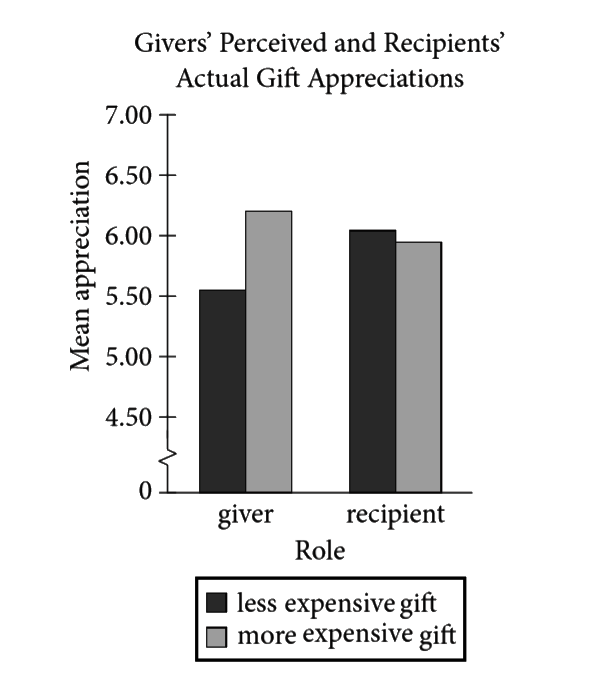
13. The authors indicate that people value gift-giving because they feel it
View SolutionEvery day, millions of shoppers hit the stores in
full force—both online and on foot—searching
frantically for the perfect gift. Last year, Americans
spent over $30 billion at retail stores in the month of
5 December alone. Aside from purchasing holiday
gifts, most people regularly buy presents for other
occasions throughout the year, including weddings,
birthdays, anniversaries, graduations, and baby
showers. This frequent experience of gift-giving can
10 engender ambivalent feelings in gift-givers. Many
relish the opportunity to buy presents because
gift-giving offers a powerful means to build stronger
bonds with one’s closest peers. At the same time,
many dread the thought of buying gifts, they worry
15 that their purchases will disappoint rather than
delight the intended recipients.
Anthropologists describe gift-giving as a positive
social process, serving various political, religious, and
psychological functions. Economists, however, offer
20 a less favorable view. According to Waldfogel (1993),
gift-giving represents an objective waste of resources.
People buy gifts that recipients would not choose to
buy on their own, or at least not spend as much
money to purchase (a phenomenon referred to as
25 ‘‘the deadweight loss of Christmas”). To wit, givers
are likely to spend $100 to purchase a gift that
receivers would spend only $80 to buy themselves.
This ‘‘deadweight loss” suggests that gift-givers are
not very good at predicting what gifts others will
30 appreciate. That in itself is not surprising to social
psychologists. Research has found that people often
struggle to take account of others’ perspectives—
their insights are subject to egocentrism, social
projection, and multiple attribution errors.
35 What is surprising is that gift-givers have
considerable experience acting as both gift-givers and
gift-recipients, but nevertheless tend to overspend
each time they set out to purchase a meaningful gift.
In the present research, we propose a unique
40 psychological explanation for this overspending
problem—i.e., that gift-givers equate how much they
spend with how much recipients will appreciate the
gift (the more expensive the gift, the stronger a
gift-recipient’s feelings of appreciation). Although a
45 link between gift price and feelings of appreciation
might seem intuitive to gift-givers, such an
assumption may be unfounded. Indeed, we propose
that gift-recipients will be less inclined to base their
feelings of appreciation on the magnitude of a gift
50 than givers assume.
Why do gift-givers assume that gift price is closely
linked to gift-recipients’ feelings of appreciation?
Perhaps givers believe that bigger (i.e., more
expensive) gifts convey stronger signals of
55 thoughtfulness and consideration. According to
Camerer (1988) and others, gift-giving represents a
symbolic ritual, whereby gift-givers attempt to signal
their positive attitudes toward the intended recipient
and their willingness to invest resources in a future
60 relationship. In this sense, gift-givers may be
motivated to spend more money on a gift in order to
send a “stronger signal” to their intended recipient.
As for gift-recipients, they may not construe smaller
and larger gifts as representing smaller and larger
65 signals of thoughtfulness and consideration.
The notion of gift-givers and gift-recipients being
unable to account for the other party’s perspective
seems puzzling because people slip in and out of
these roles every day, and, in some cases, multiple
70 times in the course of the same day. Yet, despite the
extensive experience that people have as both givers
and receivers, they often struggle to transferinformation gained from one role (e.g., as a giver)
and apply it in another, complementary role (e.g., as
75 a receiver). In theoretical terms, people fail to utilize
information about their own preferences and
experiences in order to produce more efficient
outcomes in their exchange relations. In practical
terms, people spend hundreds of dollars each year on
gifts, but somehow never learn to calibrate their gift
expenditures according to personal insight.

14. Which choice provides the best evidence for the answer to the previous question?
View Solution
